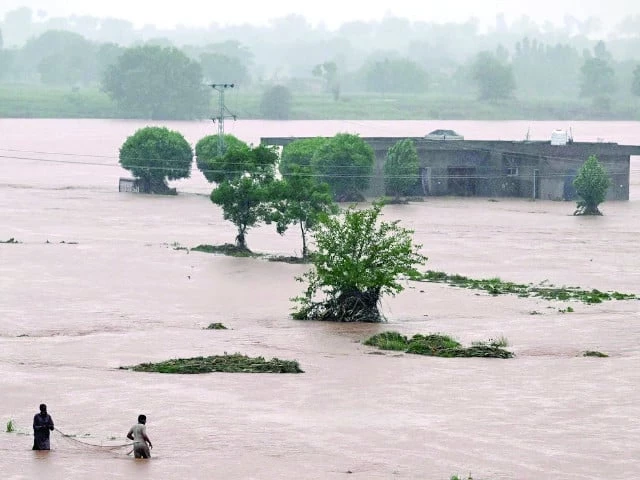Business
SBP to hold rate as floods fuel inflation | The Express Tribune

KARACHI:
Pakistan’s central bank is expected to keep its key rate steady on Monday, a Reuters poll showed, as floods that ravaged farmland and threaten fresh food inflation prompt policymakers to extend their pause on monetary easing.
Thirteen of 14 analysts surveyed forecast the State Bank of Pakistan (SBP) will hold its policy rate at 11%, while one projected a 50 basis-point cut.
Since late June, floods have swamped Punjab’s farmland, disrupting supply chains and stoking inflation fears, with nearly 950 people killed, 6,500 livestock lost, 8,200 houses destroyed and 4.5 million displaced as waters move south.
“Given the uncertainty, we expect the central bank may pause in September, though our base case allows for a 50100 bps cut by year-end,” said Waqas Ghani, Head of Research at JS Global Capital.
Analysts flag GDP hit, food price shocks
Sana Tawfik, Head of Research at Arif Habib Limited, said agricultural losses could shave around 0.2% off gross domestic product (GDP) growth, though reconstruction may provide some offset.
Analysts said flood-driven supply shocks, especially in wheat, rice and vegetables, could keep inflation above the central bank’s 57% target.
Saad Hanif of Ismail Iqbal Securities said food inflation could face “temporary shocks”, with wheat prices up about 50% in a month.
Inflation eased to 3% in August from 4.1% in July, but the finance ministry, which projected 4% to 5%, warned crop losses and extreme weather could soon push prices higher.
“Manufacturers have also raised selling prices, citing higher fuel and transport costs and delays in input deliveries caused by flooding,” said Ahmad Mobeen, Senior Economist at S&P Global Market Intelligence.
The SBP has cut rates by 1,100 basis points since June 2024, when they stood at a record 22% after inflation peaked near 40% in 2023. It last cut rates by 100 bps in May, after a March pause, and held steady in June amid oil price pressures from Middle East tensions.
Still, some see room for cuts
“Real interest rates are still high enough to allow for a cut, especially with the Fed turning dovish, but the floods are inflationary, particularly for food,” said Ammar Habib, an independent analyst.
ADB warns to insure against floods
Meanwhile, an Asian Development Bank (ADB) expert urged Pakistan, and other countries in Asia and the Pacific, to integrate insurance into urban planning to limit flood losses and speed recovery.
Arup Kumar Chatterjee, Principal Financial Sector Specialist at ADB, said on Friday that cities like Lahore in Pakistan and Gurugram, India, face severe flooding risks but remain financially exposed due to poor planning. Streets turn into rivers and homes into ruins, leaving cities in financial peril. “These issues are not random; they are the result of poor planning,” he noted.
“In 2023, natural hazards in Asia and the Pacific caused $65 billion in losses, with 91% of that amount uninsured. In 2024, global insured losses reached $135 billion, showing a huge protection gap of nearly 90%,” wrote Chatterjee.
The ADB official pointed out that ancient cities managed risks better. Mohenjo-Daro in Pakistan and the aqueducts in Rome were designed to withstand floods.
“Today’s approach to disaster management has changed. Governments often focus more on post-disaster relief than on flood prevention. This often leads to different government departments working in isolation and ignoring risk management,” he said.
The cost of neglecting insurance is clear. He pointed out that Bangkok’s 2011 floods caused $47 billion in damage, with only a third insured. Chennai’s 2015 floods brought $3.5 billion in losses, with just 34% covered. Recent storms in Dubai also exposed major gaps.
In contrast, cities that adopt insurance fare better. During Valencia’s 2024 floods, a third of $10 billion in damages was insured. Auckland’s 2023 floods had 40% coverage, allowing 112,000 claims to be processed quickly.
“We have the tools to manage flood risks better, including satellite technology and real-time data analysis. If we can predict floods, we should also be able to finance protection in advance,” stressed Chatterjee.
He urged that insurance be treated as infrastructure. Quick payouts based on rainfall data can help communities recover faster. He urged Pakistan and other governments to make coverage accessible, including for renters and low-income families.
“No major project should proceed without a risk financing plan,” he said, adding that, “Floods are inevitable; the question is whether we can respond quickly enough to prevent despair. Every uninsured project is a risk to taxpayers, costing them in both money and stress. Cities need to embrace insurance as a foundational element of their planning, not as an afterthought.”
The cost of being unprepared, he warned, far outweighs the cost of insurance.
REUTERS WITH ADDITIONAL INPUT FROM OUR CORRESPONDENT
Business
Honda Motor to make India global mfg hub for new EV – The Times of India

TOKYO: Japanese carmaker Honda Motor will make India a global manufacturing hub for its upcoming electric, Honda 0 α (alpha), whose prototype was unveiled at the Japan Mobility Show.The car has been developed for the Indian and Japanese markets, apart from other Asian countries. Its India debut will be in fiscal 2026-27. Honda Motor Co president and global CEO Toshihiro Mibe said the launch will further the company’s goal to achieve carbon neutrality and zero traffic collision fatalities worldwide by 2050.Honda 0 α (alpha) will be manufactured at Honda’s plant in Alwar, Rajasthan. Honda also launched other electric prototypes, including a green saloon. Honda India MD and CEO Takashi Nakajima said India is one of the top three markets for the company globally in terms of corporate focus and investments. Speaking on the eve of Honda’s new car launch at the Japan Mobility Show, Nakajima said, “Our top management has decided to focus on India among the three key markets for Honda’s future growth alongside the US and Japan.” Nakajima acknowledged that while Honda’s business scale in India is still low compared to the US or Japan, its future ambitions are substantial.He admitted that expanding the product line-up in India will take several years, but hinted at imminent progress. “India is one of the most promising and exciting markets in the world today. Our two-wheeler business is already very big, and now we aim to pursue strong growth in our four-wheel business by building both brand and volumes.” On ethanol blending, Nakajima said that while the higher ratio of ethanol posed challenges, Honda’s engineers were up to it. (The writer is in Tokyo at the invitation of Honda Motor Co.)
Business
Tech giants are spending big on AI in a bid to dominate the boom

The titans of the technology sector are ramping up their spending on artificial intelligence, as they rush to reap the benefits of an AI boom that has pushed stocks to record highs.
Earnings reports from Meta, Alphabet and Microsoft on Wednesday reaffirmed the colossal amounts of money these firms are shelling out for everything from data centres to chips, even as questions swirl about returns on the investments.
Meta said its capital expenditures for 2025 will be between $70bn (£53bn) to $72bn, up from an earlier estimate of $66bn to $72bn.
Its spending growth in 2026 is poised to be “notably larger” than this year, the company said. Meta is seeking to compete with companies like OpenAI.
On a call with analysts, Meta boss Mark Zuckerberg defended the firm’s investments, saying he saw big opportunities ahead driven by AI, both in terms of new products and for honing its current business selling ads and feeding people content.
“The right thing to do is accelerate this,” he said, adding later: “We are sort of perennially operating the family of apps and ads business in a compute-starved state at this point.”
Google and YouTube owner Alphabet similarly raised its forecast for this year to $91bn to $93bn, up from an earlier outlook of $85bn in the summer, in the latest sign of its increasingly lofty spending goals,
That estimate is nearly double the capital expenditures that the company reported for 2024.
Microsoft’s capital expenditures in the quarter through to 30 September, including on data centres, totalled $34.9bn, the company reported on Wednesday – a larger spending figure than analysts had expected, and up from $24 billion in the previous quarter.
“We continue to increase our investments in AI across both capital and talent to meet the massive opportunity ahead,” Satya Nadella, Microsoft’s chief executive, said.
Azure, the firm’s cloud computing unit, and Microsoft’s other AI products have a “real-world impact”, Mr Nadella said.
Exuberance among investors about massive AI spending has helped all three tech firms outperform the broader S&P 500 index.
But Wall Street is also focused on whether these firms’ investments are starting to yield tangible returns.
The two things holding up the US economy in the last several months have been consumers and AI-related business investments, said Aditya Bhave, senior US economist at Bank of America.
“To the extent that the latter remains strong, it’s a bullish signal for GDP growth,” he said.
Business
FDA to speed up approvals of generic biologic medicines as Trump targets high drug costs

U.S. Food and Drug Administration Commissioner Marty Makary speaks during a press conference alongside U.S. Secretary of Health and Human Services Robert F. Kennedy Jr., and Centers for Medicare & Medicaid Services Administrator Mehmet Oz, discussing administration plans to lower drug costs, at the Department of Health and Human Services in Washington, D.C., U.S., Oct. 29, 2025.
Annabelle Gordon | Reuters
The Food and Drug Administration on Wednesday said it will take steps to speed up the process of developing generic versions of complex biological drugs, in a bid to increase cheaper competition for expensive medicines and lower drug costs for Americans.
It’s the Trump administration’s latest move to rein in high prescription drug costs in the U.S., where medication prices are two-to-three times higher than those in other developed nations.
The move to support the development and approval of so-called biosimilars could be a blow to pharmaceutical companies, whose most profitable products are often biological products that treat serious and chronic diseases. The exact impact will depend on the drugmaker and its products.
In a statement on Wednesday, a Health and Human Services Department spokesperson said the law gives manufacturers 12 years of exclusivity for biologic medicines, which is a “primary determining factor in drug development decision-making.”
“No manufacturer should anticipate a monopoly or anything else beyond what is legally granted,” the spokesperson said.
The FDA’s new reforms “will take the five-to-eight year timeframe to bring a biosimilar to market and cut it in half,” the agency’s Commissioner Marty Makary said during a press conference on Wednesday.
During the event, HHS Secretary Robert F. Kennedy Jr. said the FDA has an “outdated and burdensome approval process that has slowed down the entry of biosimilars.” He said “even when [the drugs] do get approved, current laws often prevent pharmacists or patients from substituting them for patients who would benefit from a more affordable option.”
“That all ends today, a the FDA is taking bold, decisive action to break down these barriers and open the markets for real competition,” Kennedy said.
Biological products are engineered with living cells, which makes manufacturing more complex than for chemically derived drugs. Biologics have a special pathway to FDA approval, and it is harder for generic drug manufacturers to sell cheaper versions due to the high costs of development and difficult regulatory landscape.
Biologic medications make up only 5% of prescriptions in the U.S., but account for 51% of total drug spending as of 2024, according to an FDA release. FDA-approved biosimilars are as safe and effective as their branded counterparts, yet their market share remains below 20%, the agency added. The FDA said it has so far approved 76 biosimilars, making up only a small fraction of approved biologic drugs.
Kennedy said biosimilars, on average, cost half the price of their branded counterparts. Their entry into the market drives down brand-name drug prices by another 25%, which is a “real relief for patients,” he added.
Biosimilar generics saved $20 billion in U.S. health-care costs last year alone, the FDA said.
In a new draft guidance, the FDA proposed major updates to simplify biosimilar studies. For example, the agency recommended that human studies directly comparing the biosimilar to a branded product may not be necessary for drug companies to conduct. That research takes years and costs tens of millions of dollars.
Biosimilars have historically struggled to gain market share from their branded counterparts compared to generic copies of small-molecule drugs, which are often delivered in pill form and can enter cells easily because it has a low molecular weight.
The difference is that many biosimilars aren’t identical copies of branded biologic drugs, while generics are.
In many cases, pharmacists can’t directly substitute a branded biologic for a biosimilar when filling a prescription unless they are classified as “interchangeable” and it is permitted by state law.
But the FDA on Wednesday said it generally recommends against requiring so-called “switching studies,” which determine whether biosimilars have that classification. That step is not required for generic copies of small-molecule drugs.
“These additional studies can slow development and create public confusion about biosimilar safety,” the FDA said in a release.
-

 Fashion1 week ago
Fashion1 week agoChinese woman charged over gold theft at Paris Natural History Museum
-

 Entertainment1 week ago
Entertainment1 week agoJohn Grisham unveils his first-ever mystery, “The Widow”
-

 Tech1 week ago
Tech1 week agoEaster Island’s Moai Statues May Have Walked to Where They Now Stand
-

 Tech1 week ago
Tech1 week agoThis Smart Warming Mug Is Marked Down by $60
-

 Fashion1 week ago
Fashion1 week agoThe North Face and Cecilie Bahnsen launch second collaboration
-

 Politics5 days ago
Politics5 days agoTrump slams ‘dirty’ Canada despite withdrawal of Reagan ad
-

 Entertainment1 week ago
Entertainment1 week agoPrince Harry hit with an accusation: ‘Don’t blame us!’
-
Sports1 week ago
These five NBA players could be ready for an all-star breakthrough












